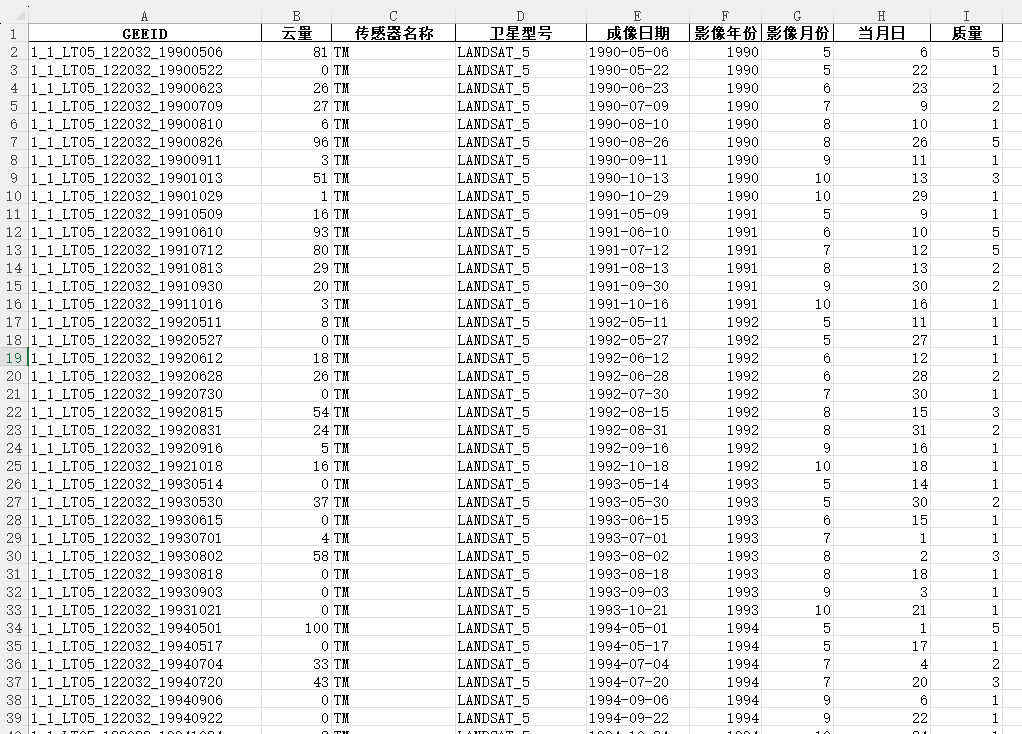GEE统计特定区域特定时间上的Landsat/Sentinel的影像信息
GEE统计特定区域特定时间上的Landsat/Sentinel的影像信息
- 前言
- 统计Landsat影像的信息
- 统计Sentinel影像的信息
前言
很多时候,我们会想查看一个特定的研究区和研究时间范围内的Landsat 或者 Sentinel系列数据集中影像的一些参数信息,如成像时间,云量,数量等等,以帮助我们确定应该如何筛选影像。比如,我想知道1990年至2020年期间,所有覆盖到北京市的Landsat影像的信息,如下图所示。Landsat系列和Sentinel系列是目前使用最为广泛的两个影像数据集,现在,我提供了实现这一操作的代码框架,大家可以在此基础上进行修改,以得到你想要提取的信息。基于此框架,你还可以扩展到其他影像数据集(如MODIS等)。

统计Landsat影像的信息
统计Landsat系列信息的代码如下:
import ee
import geemap
import pandas as pd
geemap.set_proxy(port=7778)
geemap.ee_initialize()
Map = geemap.Map()# 加载研究区
json_path = './北京市.geojson'
study_region = geemap.geojson_to_ee(json_path)
bound = study_region.bounds()
start_year = 1990
end_year = 2020
start_month = 4
end_month = 10# 创建Landsat影像集合,过滤日期和区域
landsat5 = ee.ImageCollection("LANDSAT/LT05/C02/T1_L2")
landsat7 = ee.ImageCollection("LANDSAT/LE07/C02/T1_L2")
landsat8 = ee.ImageCollection("LANDSAT/LC08/C02/T1_L2")
landsat9 = ee.ImageCollection("LANDSAT/LC09/C02/T1_L2")landsat_collection1 = ee.ImageCollection.merge(landsat5, landsat7)
landsat_collection2 = ee.ImageCollection.merge(landsat8, landsat9)
landsat_collection = ee.ImageCollection.merge(landsat_collection1, landsat_collection2) \.filterBounds(study_region) \.filter(ee.Filter.calendarRange(start_year, end_year, 'year')) \.filter(ee.Filter.calendarRange(start_month, end_month, 'month'))# 云量和质量等级函数
# 云量小于20%-1级,20%到40%-2级,40%-60%-3级, 60%-80%-4级,大于80%-5级
def assign_quality(cloud_coverage):if 0 <= cloud_coverage < 20:return 1elif 20 <= cloud_coverage < 40:return 2elif 40 <= cloud_coverage < 60:return 3elif 60 <= cloud_coverage < 80:return 4elif 80 <= cloud_coverage <= 100:return 5else:return None # 提取影像的日期和传感器信息
def extract_info(image):date = image.date().format('YYYY-MM-dd')satellite = image.get('SPACECRAFT_ID')sensor = image.get('SENSOR_ID')year = image.date().get('year')month = image.date().get('month')day = image.date().get('day')cloud_coverage = image.get('CLOUD_COVER')quality = ee.Algorithms.If(ee.Number(cloud_coverage).lt(20), 1,ee.Algorithms.If(ee.Number(cloud_coverage).lt(40), 2,ee.Algorithms.If(ee.Number(cloud_coverage).lt(60), 3,ee.Algorithms.If(ee.Number(cloud_coverage).lt(80), 4, 5))))imgID = image.id()return ee.Feature(None, {'成像日期': date,'卫星型号': satellite,'传感器名称': sensor,'影像年份': year,'影像月份': month,'当月日': day,'云量': cloud_coverage,'质量': quality,'GEEID': imgID})# 应用函数并创建特征集合
image_data = landsat_collection.map(extract_info)
feature_collection = ee.FeatureCollection(image_data)# 获取数据并转换为DataFrame
data = feature_collection.getInfo()
features = data['features']
records = []for feature in features:records.append(feature['properties'])# 创建DataFrame
df = pd.DataFrame(records)# 导出为Excel文件
df.to_excel('./landsat_statistic.xlsx', index=False)
在这段代码中,我统计1990年-2020年北京市生长季(4-10月)的Landsat影像的信息,最总结果输出为’landsat_statistic.xlsx’的excel表格。
统计Sentinel影像的信息
统计Sentinel影像信息的代码与统计Landsat影像的代码思路是一致的,以下是详细代码:
import ee
import geemap
import pandas as pd
geemap.set_proxy(port=7778)
geemap.ee_initialize()
Map = geemap.Map()# 加载研究区
json_path = './北京市.geojson'
study_region = geemap.geojson_to_ee(json_path)
bound = study_region.bounds()
start_year = 1990
end_year = 2020
start_month = 4
end_month = 10# 创建Sentinel-2影像合集
s2Collection = (ee.ImageCollection("COPERNICUS/S2_SR_HARMONIZED").filterBounds(study_region).filter(ee.Filter.calendarRange(start_year, end_year, 'year')).filter(ee.Filter.calendarRange(start_month, end_month, 'month')))# 云量和质量等级函数
def assign_quality(cloud_coverage):if 0 <= cloud_coverage < 20:return 1elif 20 <= cloud_coverage < 40:return 2elif 40 <= cloud_coverage < 60:return 3elif 60 <= cloud_coverage < 80:return 4elif 80 <= cloud_coverage <= 100:return 5else:return None # 提取影像的日期和传感器信息
def extract_info(image):img_id = image.get('system:id')date = image.date().format('YYYY-MM-dd')year = image.date().get('year')month = image.date().get('month')day = image.date().get('day')doy = ee.Date(image.get('system:time_start')).getRelative('day','year').add(1)cloud_coverage = image.get('CLOUDY_PIXEL_PERCENTAGE')quality = ee.Algorithms.If(ee.Number(cloud_coverage).lt(20), 1,ee.Algorithms.If(ee.Number(cloud_coverage).lt(40), 2,ee.Algorithms.If(ee.Number(cloud_coverage).lt(60), 3,ee.Algorithms.If(ee.Number(cloud_coverage).lt(80), 4, 5))))return ee.Feature(None, {'ID': img_id,'成像日期': date,'影像年份': year,'影像月份': month,'当月日': day,'云量': cloud_coverage,'质量': quality,'doy': doy})# 应用函数并创建特征集合
image_data = s2Collection.map(extract_info)
feature_collection = ee.FeatureCollection(image_data)# 获取数据并转换为DataFrame
data = feature_collection.getInfo()
features = data['features']
records = []for feature in features:records.append(feature['properties'])# 创建DataFrame
df = pd.DataFrame(records)# 导出为Excel文件
df.to_excel('./S2影像信息统计.xlsx', index=False)
这段代码同样统计了1990至2020年北京市生长季的Sentinel2的影像信息
